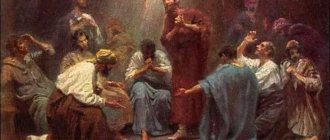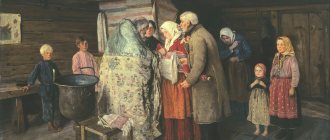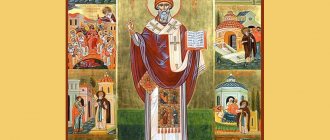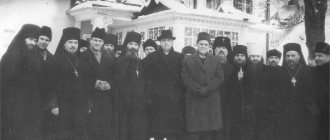| Queen Theodora. Mosaic. Church of St. Vitaliy in Ravenna (fragment) |
Theodora
(+ 548), famous Byzantine empress, wife of St. Justinian the Great, blessed queen. Memory 14 November
She was born in the very first years of the century into a family of very low rank: she was the daughter of a certain Akaki, who served as the keeper of bears in the Constantinople amphitheater. Without receiving any proper upbringing and education, she spent her childhood, so to speak, behind the scenes of the hippodrome; she was raised by the atmosphere that surrounded this entertainment center of the vast, depraved capital. Her older sisters played her on stage; She herself acted as a child in minor roles and soon gained fame as a participant in live pictures and pantomimes of the most obscene content. Panegyrists and even opponents admired her original beauty, “which neither word nor art can depict.” Small in stature, thin, somewhat pale, she amazed not so much with the majesty of her posture, but with the grace of her figure and elegance of movements, not so much with the correctness of her features, but with the sparkle of her eyes, full of defiant fire and passion, a luxurious wave of long black curls, sparkling wit and endless gaiety. Procopius, her main accuser for the shameful sins of her youth, directly says that her charms have become public property and that her countless love affairs surpassed the similar exploits of Messalina in their audacity and cynicism.
Success on the stage and the seductive charm of her appearance brought Theodora closer to the powerful of the world; she seems to have left Constantinople very early, taken away by some provincial governor. Soon abandoned by him, she was forced for some time to eke out the existence of a wandering actress and courtesan of the lowest standard in various cities of the East. Circumstances brought her to the capital again when she was only in her twenties. Here she rose to higher realms; not satisfied with noble admirers and generous gifts, she sought lasting greatness and power. She began to lead a more restrained life, trying to acquire knowledge and polish, which she succeeded in doing, thanks to her natural talent.
Fate brought her together with Justinian, who was then already the first employee of his uncle, Emperor Justin. She ignited a deep passion in his heart. This was not only a sensual attraction, but also a serious, ardent attachment that firmly subordinated the will of Justinian. When Justin's wife, Euphemia, died in 523, not wanting to bring a woman with such a tainted past into the royal house, Justinian made Theodora his wife.
In 527 she was crowned, together with him, in the church of St. Sofia.
The extraordinary beauty and boundlessness of Theodora’s vicious courage alone cannot explain the unrelenting authority that she acquired over Justinian and which captured not only the private life of her husband, but also his state activities. Sharing the labors of government with Justinian, she undoubtedly showed outstanding talents. This suggests that in the gloomy stories of the biased Procopius about the debauchery and even the atrocities of Theodora, there is a lot of slander or, at least, exaggeration. Other contemporaries do not repeat the invective of the author of The Secret History, and a number of legends that have developed around Theodora give a much more respectable picture of her origin and youth. In any case, Theodora was the faithful wife of Justinian and behaved with the dignity of an empress, although she continued to take care of her beauty. Court honors, which she apparently valued very much, demanding the strictest compliance with even humiliating rules of etiquette from everyone, even the highest dignitaries, flattered her vanity, but a broader ambition burned in her: she wanted real, real power.
Along with a strong and passionate will, she was characterized by those forces that provide power over others: a strong and clear mind, cheerful mood, resourcefulness, self-control, perseverance in difficult situations. With all this she managed to become precious to Justinian, who was easily lost among dangers. In the terrible days of the Nika rebellion in 532, Justinian the Great owed the preservation of his kingdom to his wife. When the uprising swept the entire capital and the rioters pressed the very palace, despair took possession of the sovereign and his main advisers. It seemed impossible to them to suppress the movement. Everyone said that the emperor could only flee, taking away the treasures, taking advantage of the free exit from the palace to the sea. Only Theodora opposed this decision. The words with which she returned energy to the fallen souls of those around her were preserved: “Even if in fact there is no other salvation other than flight, I do not want to run. Anyone who has once put on a diadem should not experience its destruction, and I will not see the day in which they will no longer call me empress. If you want to flee, Caesar, go: the means are in your hands; The ships are ready, the sea is open. But I'm staying. I love the old saying that purple is the best shroud!..."
The presence of mind returned to the emperor, he called on the best commanders, the rebellion was suppressed, and Theodora earned the place in the supreme council of the empire (sacrum consistorium), which she had previously been given due to the emperor’s heartfelt weakness. Her invincible influence on her husband continued until her death. He called her, playing on the meaning of her name, “the gift of God,” and long after her death the oath to her memory was most sacred to him.
Theodora took part in all state affairs; Justinian could not resist her wishes in any way. Her name appears next to his on the dedicatory inscriptions of public buildings and in the titles of legislative acts. Statues were erected to her, praise was officially offered, and allegiance was sworn to her. She was the emperor’s equal in everything and his real right hand. She proudly wrote to King Khozroes of Persia: “The Emperor never decides anything without consulting me.”
. Justinian himself admitted this in his stories.
It is difficult to say whether she turned out to be a good adviser to him more often than an evil genius. The latter is more likely, since she was guided more by selfish calculations than by political ideas, which she had no time to develop. She was guided by likes and dislikes, intrigued for her friends, hated her enemies. The spirit of intolerance that colored the reign of Justinian found constant support in Theodore. She used her influence without any restraint; the most powerful dignitaries, if they offended her, could not escape her revenge. One of the most influential ministers of the emperor, John of Cappadocia, who managed to gain Justinian’s full trust with his financial resourcefulness, began to undermine the authority of the empress. She decided to destroy him: a network of real conspiracy was woven around the adviser, who seemed omnipotent. Theodora called on the virtuoso of intrigue, the wife of the famous commander Belisaria, Antonina, for help. A lot of energy was spent to achieve the goal, and in the end the strong enemy fell in disgrace. Even a man like Belisarius was not protected from Theodora’s wrath. She has not forgiven the Green Party for the contempt with which its members treated her when she began her stage career. Everyone bowed down before her, fearing the cruelty in which she knew no bounds.
A “woman to the core” herself, Theodora, as an empress, worked to improve the situation of persons of her sex. Laws that expanded the civil rights of women, protecting the wife from the tyranny of her husband, and the girl from the violence of the seducer, were published under her influence. She stood strongly for the strength and sanctity of marriage and established a rich shelter-monastery for repentant fallen women.
| Queen Theodora. Mosaic. Church of St. Vitaliy in Ravenna |
Like most Byzantine women, she was ardently religious and superstitiously pious, but her personal preferences prevented her from understanding the higher interests of church politics.
She stubbornly defended the Monophysites all her life, perhaps more as her friends who always stood for her, than inspired by the task of restoring religious peace in the empire. In patronizing the confessors of her beloved teaching, Theodora did not hesitate to face deceit and violence; Pope Silverius was deposed under her pressure for his obstinacy in Orthodoxy. She turned out to be the emperor's inspiration during repressions in many church unrest. According to the historian A.V. Kartashev, it was Theodora who “artificially multiplied the Monophysite ordinations and directly created and strengthened the historical existence of the Monophysite churches down to the present day.”
[1].
She died on June 28, 548, not yet reaching old age; believed to be from cancer. Justinian could not console himself with her death; Since the disappearance of his co-worker wife, his energy and initiative began to decline, his very thoughts began to degenerate.
She was canonized together with her husband Justinian as a missus. The Church recognizes Theodora’s repentance for her unrighteous life in her youth and believes that she nevertheless moved away from the Monophysite heresy and became a defender of Orthodoxy. Hagiographic literature contains very brief information about Theodore.
Folk signs on June 9 (St. John the Russian)
• If you do field work on this day, you may not expect a harvest. • If the stove smoke spreads along the ground and does not rise up, then it will rain soon. • Earthworms crawling on the surface of the earth indicated precipitation. • If a woodpecker is actively knocking in clear weather, then there will soon be bad weather. • If the night dew has not disappeared by noon, then this is a sign of a thunderstorm. • Daily fogs in the morning indicated a rich harvest of mushrooms. • What the weather is like on June 9th, the same will be the first days of autumn. • Heavy morning dew indicated a good harvest.
Name day on June 9 (St. John the Russian, Martyr Theodora) is celebrated by Leonid. Anastasia, Diana, Ivan, Leonty, Peter, Fedora.
Select another day of remembrance of a saint by date of birth
Sources and historiography[ | ]
Holy Queen Theodora
(Greek icon, 19th century)
The main source of Theodora’s biography is the work of Theophanes, the successor, “ Biographies of the Byzantine kings
" In this source, Theodora’s life is described in two sections: “Theophilus” (describes the period from her birth to the death of her husband, Emperor Theophilus) and “Michael III” (describes the period of her regency, departure from control of the empire and death). Hagiographic literature does not contain detailed information about Theodora, limiting itself to pointing out her merits in restoring icon veneration[35].
George Amartol, a contemporary of Theodora, finished his chronicle in 842, that is, on the eve of Theodora’s rise to power. The successor of Theophanes and Joseph Genesius[36], whose works set out the life and deeds of Theodora, wrote their works at the behest of Emperor Constantine Porphyrogenitus[37] a century after the reign of Basilisa Theodora.
Among modern historians, the French author Charles Diehl has repeatedly written about Theodore in his series of works on the history of the Byzantine Empire. Theodora’s activity in restoring icon veneration was examined in detail by the church historian Kartashev in his work “ Ecumenical Councils”
».
Folk traditions June 9
On June 9, healers began collecting yarrow flowers, from which they subsequently prepared healing infusions and decoctions. Women and girls were forbidden to communicate with each other, because this supposedly foreshadowed a terrible attack. Any gossip on June 9 (St. John the Russian, Martyr Theodora) was prohibited, because it was believed that any word spoken in vain on this day would go around all houses. Squabbles and infighting were also taboo. The house was not cleaned, because it was believed that family happiness could be taken out along with the trash. In addition, they believed that a brownie or stove could accidentally climb onto a broom. As a result of cleaning, it was possible to take them out and thus lose the real owner. On this day, merchants cooked a special porridge in a pot for the brownie. Coins were placed in the pot and then placed behind the stove. In this way, people bribed the owner of the house and hoped that the brownie would bring good luck. No transactions were made that day.
Restoration of icon veneration[ | ]
Discussion on issues of faith and icons with the participation of Empress Theodora
. Miniature from the Chronicle of John Skylitzes, early 13th century
Council of Constantinople 843[ | ]
The restoration of icon veneration was carried out by Theodora immediately after the death of Emperor Theophilus. On the fortieth day of his death, a church council was convened in Constantinople for this purpose. To restore icon veneration, it was necessary to replace the iconoclast patriarch John the Grammar. Theodora, on the advice of Manuel, sent a letter to John asking him to leave the patriarchal throne. Having received this ultimatum from Theodora, John asked for time to think, after which he inflicted harmless wounds to his stomach with a knife, and then declared that Theodora's messenger was trying to kill him. An investigation was carried out, according to which the patriarch was found, citing the testimony of his servants, guilty of deliberately inflicting wounds on himself in order to cause unrest in society.[8] John was deposed from the pulpit by a church council “for attempting suicide.
", expelled from the church and exiled to his estate in the village [23] (according to other sources, he was imprisoned in the Klidion monastery on the Bosphorus [24]).
According to the chronicle of George Amartol, after his exile, John scraped out the eyes of several icons, for which “ they inflicted 200 wounds on him with belt lashes
.”[25]
Methodius, who suffered from the iconoclasts, was elected the new Patriarch of Constantinople. At the council, a tomos was read and approved, the text of which has not been preserved, but from other sources it is known that it proclaimed the need to restore the veneration of icons, confirmed the legality of the decisions of the seven ecumenical councils and anathematized iconoclasm.[26] The council also returned from exile all those previously convicted of venerating icons; iconoclast bishops were expelled from their cathedras, to which the bishops who had suffered under Theophilus returned[13].
One of the requests of Empress Theodora when restoring the veneration of icons was not to pronounce anathema on her late husband and absolve him of his sins. To the objection of Patriarch Methodius that the church has the right to forgive the living who bring repentance, but cannot do anything about a person who died in a state of mortal sin, Theodora said that before his death the emperor repented of his sins and kissed the icon brought by Theodora.[27] Some historians believe that this was a pious deception of Theodora, who loved her husband[13], others, however, do not deny the possibility that during her husband’s last breath she put the icon to his lips, following her religious beliefs.[23] After listening to Theodora, the council decided to pray throughout all the churches of the capital for a week for the salvation of the soul of the late emperor.
Church tradition reports that Patriarch Methodius, in order to decide on the absolution of Theophilus, wrote the names of all the iconoclast emperors on parchment and placed it on the altar in the altar of Hagia Sophia, and then in a dream he saw an angel announcing that God had mercy on the emperor. In the morning, in confirmation of the dream, the patriarch saw that on the parchment the place with the name Theophilus had turned white, which was regarded as a sign of forgiveness.[13] After this, the council confirmed in writing the absolution of the emperor. However, later some church leaders reproached Theodora for this. When Theodora, during a feast on the occasion of the Triumph of Orthodoxy, was saddened by seeing burnt letters on the forehead of the Monk Theophan (punishment for venerating icons), he said: “ For this inscription I will sue your husband and the king before the impartial judgment seat of God.”
".[4] However, the patriarch and other bishops confirmed the absolution of Theophilus[13].
“Triumph of Orthodoxy”[ | ]
Main article: Triumph of Orthodoxy
After the church council, Theodora organized a church celebration, which fell on the first Sunday of Lent, which was in 843 [28] March 11 [18] [29] (according to other sources - February 19 [30]).
According to the church historian Kartashev, one of the Byzantine chroniclers described this event in this way: Empress Theodora and Emperor Michael III
Icon “Triumph of Orthodoxy” (fragment). Byzantium, first half of the 15th century
The queen invited His Holiness Patriarch Methodius to notify and gather all Orthodox metropolitans, archbishops, abbots, clergy and laity to come to the Great Church of God with honorable crosses and holy icons on the first Sunday of Holy Lent. And when countless people had gathered, Tsar Michael himself came with his holy and Orthodox mother Theodora and with the entire synclite... having united with the holy Patriarch, they moved together from the altar with the holy icons and the honorable cross and the holy gospel and went with the litia to the gates of the palace, the so-called Centaurids. And after a long prayer and a contrite, mournful and tender cry, Κύριε ελέησον[31] returned to the holy temple to celebrate the divine mysterious liturgy with great joy and triumph. And thus the holy and honorable icons were restored for veneration and worship in the temple of God. The pious autocrats, together with the all-honorable and holy Patriarch Methodius and the metropolitans and venerable ascetics who were then with him, decreed: annually on the first Sunday of Holy Lent, solemnly celebrate in the Great Church of God this holy and honest holiday, which is celebrated to this day. The icons were simultaneously placed in all the churches of Constantinople.[23]
In memory of this event, significant for the Christian world, and in memory of Blessed Theodora, every year on the first Sunday of Great Lent, the Orthodox Church solemnly celebrates the restoration of icon veneration, called the “Triumph of Orthodoxy.”
Reaction period[ | ]
On a gold solidus from the time of Theodora's regency, little Michael III is depicted with his sister Thekla on the reverse, while a portrait of his mother in imperial robes is placed on the obverse.
After the Council of Constantinople, a period of reaction began in the empire. The remains of the famous confessors of Orthodoxy Theodore the Studite and Patriarch Nicephorus, who suffered for their faith and died in exile, were solemnly transferred to Constantinople. Theodora and her son and the entire courtyard came out to meet the remains, carrying candles in their hands. They followed the relics on foot to the Church of the Twelve Apostles. The tomb of Emperor Constantine V was desecrated, without any respect for the imperial dignity, his remains were thrown into the street, and the marble sarcophagus was cut into thin tiles and used as cladding for one of the rooms of the imperial palace.[13] As a sign of the victory of icon veneration, the image of Christ reappears on coins and seals after 843.[32]
During Theodora's regency, persecution of people who denied icon veneration began. Diehl reports[13] that she dreamed of the glory of exterminating heretics, and on her orders the Paulicians were offered a choice: conversion to Orthodoxy or death. After the Paulicians refused to change their religious beliefs, three military leaders were sent on punitive expeditions to the area of Asia Minor inhabited by them: Argyres, Sudalus and Ducas.[33] About a hundred thousand people died under torture at the hands of the imperial inquisitors: “ some Paulicians were crucified on the cross, others were condemned to the sword, others to the depths of the sea. About ten myriads were the number of those destroyed, their property was sent and delivered to the royal treasury
".[8] The persecution of the Paulicans began long before Theodora came to power. In defense, they entered into a military alliance with the Muslims and raided Byzantine possessions. Despite the extermination of the Paulicans under Theodore, the sect was defeated much later in 871, but the church failed to completely destroy the heresy.[34]
Notes[ | ]
- Toumanoff C.
Les dynasties de la Caucasie chrétienne de l'Antiquité jusqu'au xixe siècle (French): Tables généalogiques et chronologiques - Rome: 1990. - P. 334. - Settipani C.
Continuité des élites à Byzance durant les siècles obscurs (French): Les princes caucasiens et l'Empire du VIe au IXe siècle - Paris: 2006. - P. 310. - ISBN 978-2-7018-0226-8 - Theodora's birth year is estimated based on the following considerations: she must not be older than her husband and capable of bearing children in the early 830s. Theophilus' birth year of 813 is derived from Warren Treadgold's estimate. Some historians believe that Theophilus was born earlier, c. 805 See Senina T. A. (nun Cassia). Dialogue between Theophilus and Cassia: literary fiction or reality?
- ↑ 1 2 3 4 5
Continued by Feofan.
Lives of Byzantine kings
. Book III. Theophilus. - John H. Rosser.
Historical Dictionary of Byzantium. — 2nd ed. - Scarecrow Press, 2011. - P. 199. Original text (English)Armenians were a significant minority within the empire. In the sixth century, Justinian I's General Narses was Armenian. The emperor Maurice (582-602) may have been Armenian. In the ninth and 10th centuries there were several Armenian emperors, including Leo V, Basil I, Romanos I Lekapenos, and John I Tzimiskes. Theodora, the wife of Theophilios, was Armenian.
- Peter Charanis // The Armenians in the Byzantine Empire // Fundação Calouste Gulbenkian, 1963
Original text (English)where Manuel, uncle of Theodora, is referred to as Armenian. Though there is some confusion about the career of this Manuel, this confusion does not affect the Armenian origin of Theodora's family
- Ostrogorsky G. A
// “History of the Byzantine state” // Rutgers University Press, 1969 - pp. 219(624) ISBN 0-8135-0599-2, 9780813505992Original text (English)
It is significant that the new rulers, despite their largely eastern origin—Theodora's family came from Paphlagonia and was of Armenian descent—saw the restoration of the cult of the icons as their first and most pressing task.
- ↑ 1 2 3 4 5 6 7 8
Continued by Feofan.
Lives of Byzantine kings
. Book IV. Michael III - Bartikyan PM // Unknown Armenian aristocratic family in the service of Byzantium in the 9th-11th centuries. // Day, 1992. - Issue. 26: Byzantium and medieval Crimea. — pp. 83-91.
After him, on the Byzantine throne, we meet the Armenian Theodora (842-856), who, according to N. Adonets, belonged to the Naharar family of Mamiconids, her son Michael III (842-867).
- Kazhdan, Alexander, ed. (1991). The Oxford Dictionary of Byzantium. Oxford and New York: Oxford University Press. ISBN 0-19-504652-8. P. 1279
- Icasia (Cassia of Constantinople) took monastic vows and founded a monastery in Constantinople. She wrote several songs of the canon of Great Saturday, as well as several stichera, including the stichera “ Lord, even the wife fell into many sins
,” which, according to legend, was written after Emperor Theophilus refused to see her again (see Kartashev A. V.
Ecumenical Councils
. Klin, 2004.) - The viewing of the brides and the dialogue between Theophilus and Cassia are described in the chronicle of Simeon Logothetes. The presentation is given according to A. L. Dvorkin, “Essays on the history of the Ecumenical Orthodox Church” with a more accurate Russian translation of the dialogue according to D. E. Afinogenov, “The Tale of the Forgiveness of Emperor Theophilus.” The dialogue between Theophilus and Cassia perhaps goes back to the words in the homily of John Chrysostom “On the Annunciation of our glorious Lady Theotokos”: “ Evil flows through a woman, good things flow through a woman
.” - ↑ 1 2 3 4 5 6 7 8 9 10 11 12 13 14 15
Charles Diehl
Byzantine portraits
M., 1994. - Thekla (831), Anna (832), Anastasia (833), Constantine (834), Maria (835), Pulcheria (836), Michael (840): W Treadgold, The Problem of the Marriage of the Emperor Theophilos // Greek, Roman and Byzantine Studies, 1975. Vol. 16. P. 333—341
- Perhaps this is a legend, Arab sources report that he died during the reign of Theophilus, the latest researchers are of the same opinion: Theophobus was killed in the war with the Arabs in 839-840 (See M. Recaya, “Mise au point sur Théophobe et l'alliance de Bâbek avec Théophile (833/34-839/40)", Byzantion 44.1 (1974) 43-67; J.-Cl. Cheynet, "Théophile, Théophobe et les Perses", in: S. Lampakis (ed .), Ἡ Βυζαντινή Μικρά Ασία (6-12 αι.) (Athen, 1998) 39-50.)
- Alexander Schmeman, protopresbyter. The historical path of Orthodoxy
.
Chapter 5. Byzantium, part 6 (undefined)
(inaccessible link). Access date: December 20, 2007. Archived June 6, 2013. - Imitator of Theophanes. Lives of Byzantine kings
. Chapter IV. Michael III - ↑ 12
Collection History of Byzantium. T. 2 // Academician S. D. Skazkin (chief editor) - Moscow: Science, 1967 - Lebedev A.P. History of the division of churches. - M., 2005. pp. 263-264
- Holy Queen Theodora
- Righteous Queen of Greece Theodora
- Holy Righteous Theodora (inaccessible link)
- ↑ 1 2 3
Kartashev A.V.
Ecumenical Councils
. Klin, 2004. - John VII Grammar // Orthodox Encyclopedia. - M.: Church-Scientific, 2010. - T. XXIII: “Innocent - John Vlah.” — P. 485-486. — 752 p. — 39,000 copies. — ISBN 978-5-89572-042-4.
- Temporary of George the Monk, book. eleven
- Vasiliev A. A. History of the Byzantine Empire
- Later, this story was supplemented by legendary details that Theodora foresaw the fate of her husband and saw in her dreams the Mother of God judging Theophilus.
- For a long time, the year 842 was considered the year of restoration of icon veneration (Vasiliev A. A. History of the Byzantine Empire The second period of iconoclasm and the Restoration of Orthodoxy. The division of churches in the 9th century)
- Alexander Schmeman, protopresbyter. The historical path of Orthodoxy
.
Chapter 5. Byzantium, part 2 (undefined)
(inaccessible link). Access date: December 20, 2007. Archived January 25, 2007. - About the rite of Orthodoxy
- Greek Κύριε ελέησον - Lord have mercy
- A. Grabar. L'iconoclasme byzantin. Dossier archeologique. Paris, 1957. p. 127.
- Dashkov S. B. Emperors of Byzantium
. Theodora, Michael III Drunkard - Uspensky F.I., “History of the Byzantine Empire”, vol. 2, ch. 16 (inaccessible link)
- Memory of the Holy Queen Theodora // Lives of the Saints in Russian, set out according to the guidance of the Chetyih-Menya of St. Demetrius of Rostov: 12 books, 2 books. add. - M.: Moscow. Synod. typ., 1903-1916. — Vol. VI: February, Day 11.
- Joseph Genesius, "Book of Kingdoms". Describes the years 813-886.
- Preface // Continued by Feofan. Lives of Byzantine kings. M. Science. 1992









